Every year for St. Patrick's Day, the Chicago Plumbers Union dyes the local river green.
NPR reports that the tradition began in 1962, when Mayor Richard J. Daley wanted to dye Lake Michigan but eventually settled on the much smaller Chicago River. The dye itself is vegetable-based and food-safe, but some have questioned whether the tradition could have a dramatic impact on the local environment.
What kind of dye does the city use?
Green Matters reports that the original dye used for this tradition was fluorescein, an oil-based substance normally used to find leaks in pipes. However, due to concerns about the plants and wildlife in the river, the union switched to "Leprechaun Dust," a vegetable-based powder, in 1966.
What does the dye do?
Leprechaun Dust lasts only two days, Green Matter says. The outlet also quotes an EPA statement, which says:
"The dye used is a food grade dye also used in medicine … Illinois EPA found that at the concentration used in the Chicago River, it is completely non-toxic."
Dyeing a body of water can sometimes be beneficial. Farmers and landowners often dye their ponds to prevent algal blooms, an overgrowth of algae that can kill off other living things in the water and destroy the pond's natural balance.
The dye helps limit the amount of sunlight the algae gets so it can't grow out of control — and it usually lasts longer than the green color in the Chicago River, so it's unlikely this event is causing any direct harm.
There are concerns from environmentalists, like NiCHE Canada's Isaac Green, that dyeing the river sends the wrong message to Chicago's residents.
"Even if the dye itself isn't ecologically harmful, the process of dying the river can sustain harmful ecological ideas," Green says. "The dye allows people to believe the river isn't 'natural,' therefore justifying its treatment as a sewer."
Besides those who use the river as a "trash can," Green Matters also reports that illegal dyeing events along other parts of the river may have used less environmentally friendly dye.
"Dyeing the river continues and perpetuates the notion that we can modify rivers to suit our tastes with no regard to the consequences," Green says.
Join our free newsletter for cool news and cool tips that make it easy to help yourself while helping the planet.









